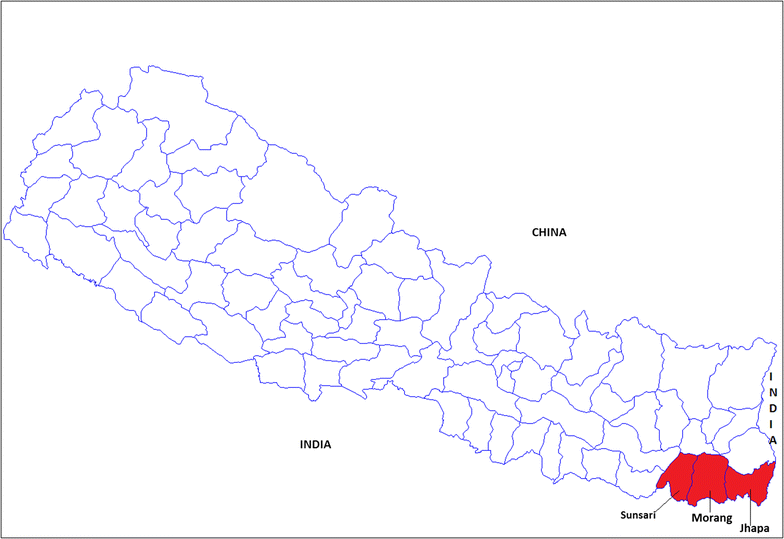Investigating aquifer contamination and groundwater quality in eastern Terai region of Nepal
- PMID: 29784017
- PMCID: PMC5963105
- DOI: 10.1186/s13104-018-3445-z
Investigating aquifer contamination and groundwater quality in eastern Terai region of Nepal
Abstract
Objective: This study aims at assessing the groundwater quality of the three districts of Eastern Terai region of Nepal viz. Morang, Jhapa, Sunsari using physicochemical characteristics and statistical approach so that possible contamination of water reservoir can be understood. pH, temperature, conductivity, turbidity, color, total dissolved solids, fluorides, ammonia, nitrates, chloride, total hardness, calcium hardness, calcium, magnesium, total alkalinity, iron, manganese, arsenic have to be analyzed to know the present status of groundwater quality.
Results: Results revealed that the value of analyzed parameters were within the acceptable limits for drinking water recommended by World Health Organization except for pH, turbidity, ammonia and iron. As per Nepal Drinking Water Quality Standards, fluoride and manganese too were not complying with the permissible limit. Electrical conductivity, total dissolved solids, chloride, total hardness, calcium hardness, manganese, and total alkalinity show good positive correlation with major water quality parameters. Calcium, magnesium, total hardness, calcium hardness and total alkalinity greatly influences total dissolved solids and electrical conductivity. ANOVA, Tukey, and clustering highlight the significance of three districts. Groundwater can be considered safe, but there is always a chance of contamination through chemical wastes in the heavily industrialized area of Morang and Sunsari Industrial corridor.
Keywords: Groundwater; Nepal; Physicochemical; Terai.
Figures
Similar articles
-
Groundwater quality assessment in upper Kabul basin and Paghman aquifer.J Environ Sci Health A Tox Hazard Subst Environ Eng. 2024;59(7):321-333. doi: 10.1080/10934529.2024.2384803. Epub 2024 Aug 19. J Environ Sci Health A Tox Hazard Subst Environ Eng. 2024. PMID: 39158527
-
Groundwater quality assessment in the village of Lutfullapur Nawada, Loni, District Ghaziabad, Uttar Pradesh, India.Environ Monit Assess. 2012 Jul;184(7):4473-88. doi: 10.1007/s10661-011-2279-0. Epub 2011 Aug 27. Environ Monit Assess. 2012. PMID: 21870214
-
Assessment of groundwater quality and human health risks of nitrate and fluoride contamination in a rapidly urbanizing region of India.Environ Sci Pollut Res Int. 2023 Apr;30(19):55437-55454. doi: 10.1007/s11356-023-26204-0. Epub 2023 Mar 9. Environ Sci Pollut Res Int. 2023. PMID: 36892698
-
Hydrogeochemical characterization and evaluation of groundwater quality in Kangayam taluk, Tirupur district, Tamil Nadu, India, using GIS techniques.Environ Geochem Health. 2019 Apr;41(2):851-873. doi: 10.1007/s10653-018-0183-z. Epub 2018 Sep 10. Environ Geochem Health. 2019. PMID: 30203219
-
Spatial distribution of arsenic in groundwater of southern Nepal.Rev Environ Contam Toxicol. 2012;218:125-40. doi: 10.1007/978-1-4614-3137-4_3. Rev Environ Contam Toxicol. 2012. PMID: 22488606 Review.
Cited by
-
Equity implications of rice fortification: a modelling study from Nepal.Public Health Nutr. 2020 Oct;23(15):2824-2839. doi: 10.1017/S1368980020001020. Epub 2020 Jul 6. Public Health Nutr. 2020. PMID: 32627728 Free PMC article.
References
-
- Sharp KA. Water: structure and properties. Encyclopedia of life sciences. New Jersey: Wiley; 2001.
-
- Siebert S, Burke J, Faures JM, Frenken K, Hoogeveen J, Doll P, et al. Groundwater use for irrigation—a global inventory. Hydrol Earth Syst Sci. 2010;14:1863–1880. doi: 10.5194/hess-14-1863-2010. - DOI
-
- Harter T. Reference: groundwater quality and groundwater pollution. Oakland: ANR Publication 8084; 2003.
-
- Rao NS. Seasonal variation of groundwater quality in a part of Guntur District, Andhra Pradesh, India. Environ Geol. 2006;2006(49):413–429.
-
- WHO . Total dissolved solids in drinking-water: background document for development of WHO Guidelines for drinking-water quality. Geneva: World Health Organization; 2011.
MeSH terms
Substances
LinkOut - more resources
Full Text Sources
Other Literature Sources
Medical
Research Materials


